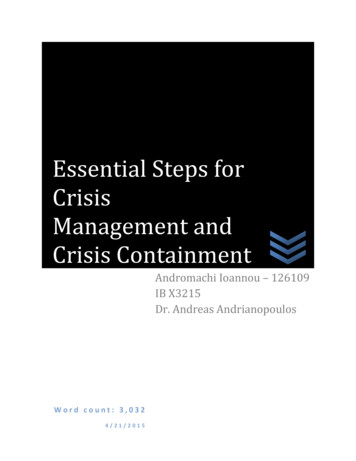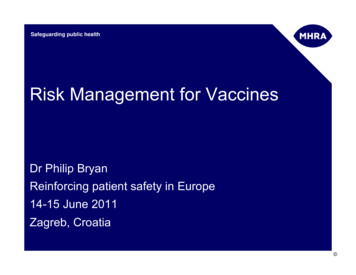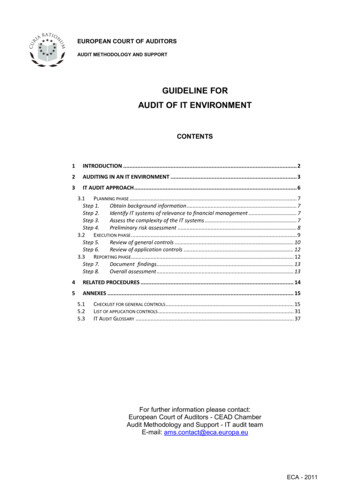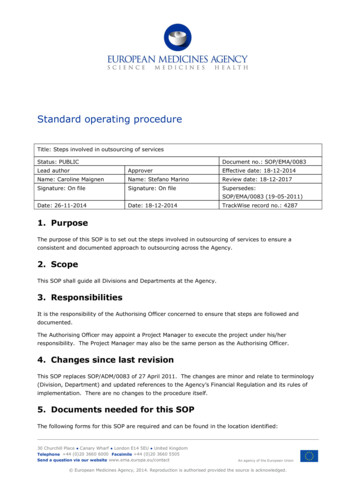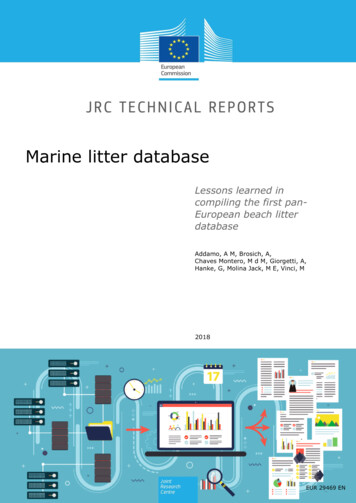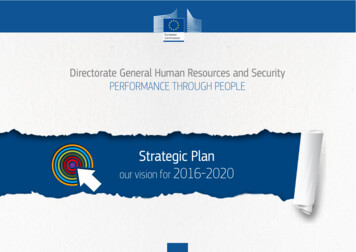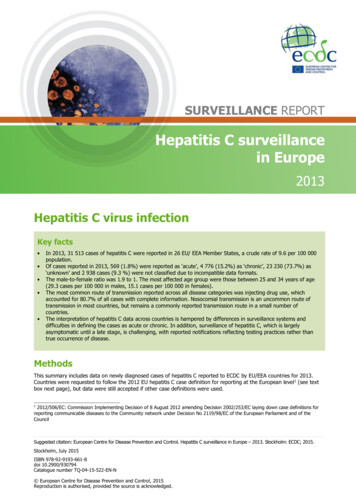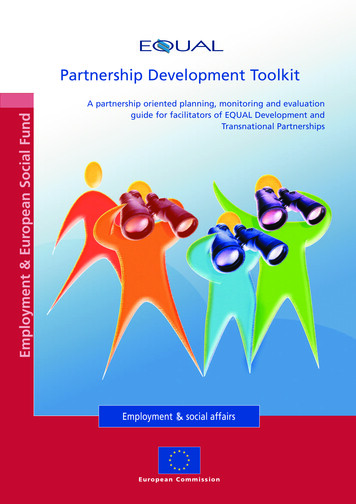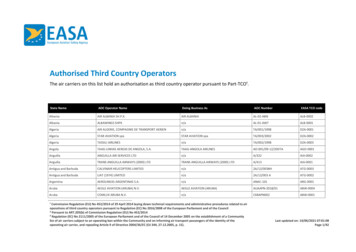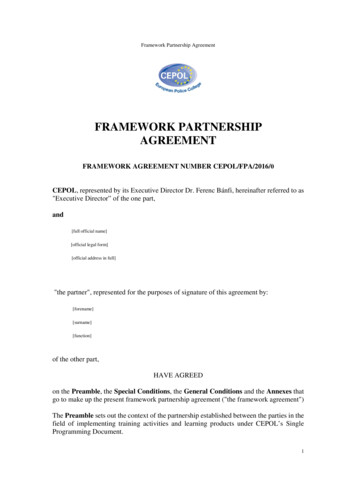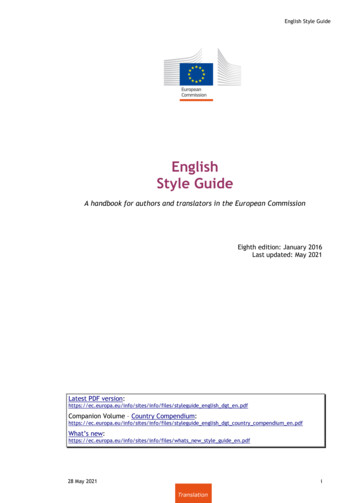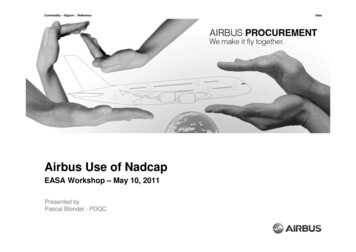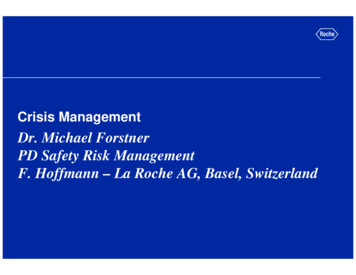
Transcription
Crisis ManagementDr. Michael ForstnerPD Safety Risk ManagementF. Hoffmann – La Roche AG, Basel, Switzerland
Risk – Issue - CrisisDifferent concepts – different managementRisk: An assessed loss potential. A function of hazard, trigger,probability of occurrence, severity of outcome.Risk analysis – risk engineering – risk management.Issue: An unsettled matter which is ready for decision.Issue management – corrective action possible.Crisis: An issue out of hand.Crisis management – maintain control of situation.
A risk getting out of handSupposed link between MMR vaccination and autism inchildren1998: Study in The Lancet claiming a possible link between MMR vaccine andautism in childrenMRC dismissed the claimsOne co-author changed his opinionUK government tried to persuade parents to vaccinate (alternative: measlesepidemic)PM Tony Blair did not comment whether his son Leo had received vaccineParents became deeply confused by mixed messages.Numerous reports published rebuking the original claim, still vaccination ratesdropped in UK and throughout Europe and US
A risk getting out of handSupposed link between MMR vaccination and autism inchildren2010: Lancet retracted paper – original findings fraudulentStill: go to „Google“ and see what people think .or look at the vaccination ratesin some areas of, e.g. SwitzerlandWhat went wrong?In emotive cases (involving health and welfare of children): understand and besensitive to emotional triggers.Don‘t fight fear with fear!Initial response through rapid report from MRC was not followed up for years bycommitment to monitoring issues and maintaining an open flow of information.Public mistrust evolved rapidly on the back of dismissive behaviour, lack ofopenness (and doubts surrounding Leo Blair‘s inoculation)
Risk perceptionFactors influencing decision on riskPressure GroupsAwarenessChoiceMediaNatureDo I put up with this?Scientific viewDreadEquityDetectability
The environmentWhat influences our judgement of risks?Values and LifestylesInternational EnvironmentPublic PolicyFormulationEthical StandardsThe OrganizationSpecial Interest GroupsInformation AgeAttitudes towards businessStakeholder Groups6
The development of a crisisPressureOpportunity to influenceMediacoveragePeriod of increasingawarenessIssue t
Issue managementPrepare an issue management plan Anticipate issues, establish priorities. Analyze issues. Recommend an organizational position on the issue. Identify groups/key opinion leaders who can advance your position. Identify desired behaviours.
if an issue is identifiedAs early as possible, implement the following types of activityIssue championsTask force set upBackground briefingmaterialsRegulatory affairsIntelligence gatheringand analysisRelationship managementResearch databaseMedia managementInformation/educationprogrammesOpinion leader developmentThe „glocal“ approach
Crisis managementTaking action in a crisis
Crisis managementTaking action in a crisisStrategic decision:when is a situation a crisis ?when to take action ?Keeping calm and continue positive thinking helps seizing the initiative–This is supported by advance planning
Crisis managementKey questions for a crisis management planDoes the company have policies and procedures in place to prevent ariskfrom turning into a crisis?Do plans exist for dealing with every aspect of the crisis should itoccur?Have the plans been tested to ensure they work satisfactorily?Which are audiences most likely to be affected by the potential crisis?Do plans include procedures for communicating effectively ?Have the communications aspects of the plan been tested as well asthecompany‘s operational response?
Preparing for a crisisNoah built the ark before it started to rainCatalogue potentialcrisis situationsTest everythingDevise policies fortheir preventionEffective communicationchannelsFormulate strategies andtactics for each crisisIdentify who will beaffected (internal/external)
The most important part of CM planning
CFC in asthma inhalersAn example of successful issue management70 million patientsworldwide1987: CFC phase outagreed.Inhalers remained asone of the lastsources of ozonedepleting CFCs.Total market: 13 billion USDalternative propellants neededpatients reluctant to change from a tried and tested devicepatients and doctors unaware of presence of CFCs in MDIsCommunication challenge: CFC in MDIs safe - the same CFCsdestroy ozone layer
CFC in asthma inhalersAn example of successful issue managementThe International Pharmaceutical Aerosol Consortium (IPAC).Communicate industry‘s commitment to changeInform influencers and decision makers about risk of asthmaEnsure that regulators agree with industry consensus that preferred method ofdrug delivery for asthma is by use of inhalersFind a replacement propellant, test it for medical use and seek regulatoryapprovalMake representations to public policy makers to secure essential useexemption for MDIs while reformulated products were developedAgree a strategy for replacement process to minimize public health risks
CFC in asthma inhalersAn example of successful issue managementConsortium: one voice for the industryAlternative propellants: HFA-134a, HFA-227but:lack of informed knowledge about MDIsCountry-by-country competition to phase outCFCsSpecial interest groups: „No exemption“ policySome groups favoured „recycling CFCs“:contamination risk, not suitableProliferation and complexity of relatedlegislation makes communication difficultDeadline for phase-out too short for properCTs
CFC in asthma inhalersAn example of successful issue managementDecision makers and influencers made aware of issues.Protocol negotiated with all member countries of the UNO,concerted approach.Messages kept simple and to the point.Imperative: no objection to central tenant of the protocol(protection of ozone layer) AND industry must not beseen to be self-serving at expense of patients.Key document developed: „An essential breathing spacefor patients“Finally: exemption was granted until 1997 – consortiumcontinued to work with authorities while new HFA-134abased propellant was developed, and throughouttransition to non-CFC MDIs
CFC in asthma inhalersAn example of successful issue managementCritical success factors: Spot the issue early while the policy situation is still fluid. Ensure that the issue is actually worth managing. In thiscase: clear business reasons AND a moral obligation topatients. Develop a strong case, based on research and supportedby influential independent endorsers. Where possible, take your case forward with othercompanies as a consortium, or with other stakeholders as acoalition of interest. Ensure that you have access to the right expertise whenyou need it and excellent campaign coordination andadministration.
There are two types of companies – those that hada crisis and those that will have one!Better be prepared„They don‘t put brakes in race cars to make them go slower. They putbrakes in race cars to make them go faster.“Al Unser, four times Indy 400 winnerSource: Claes Mårtenson, Solvay CC-RMI
We Innovate Healthcare
Crisis management – maintain control of situation. A risk getting out of hand Supposed link between MMR vaccination and autism in children 1998: Study in The Lancet claiming a possible link between MMR vaccine and autism in children. MRC dismissed the claims. One co-author changed his opinion. UK government tried to persuade parents to vaccinate (alternative: measles epidemic) PM Tony Blair .
